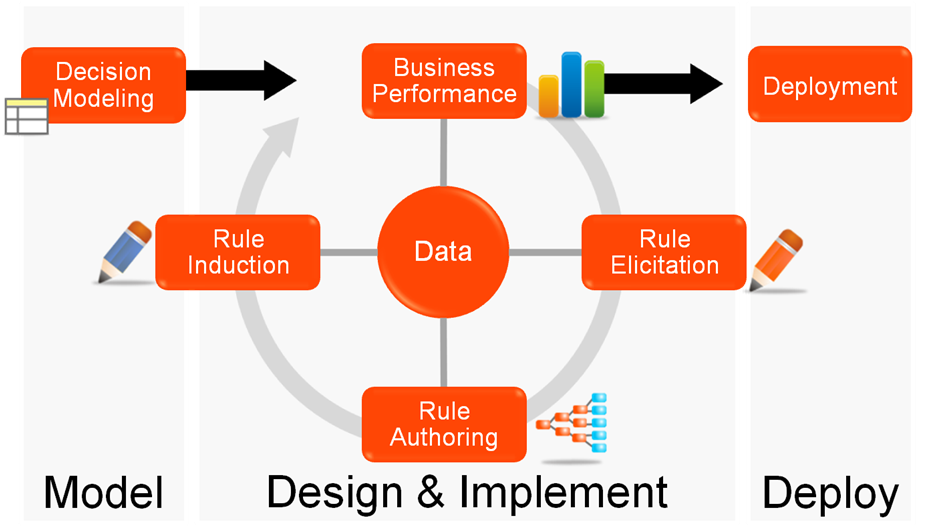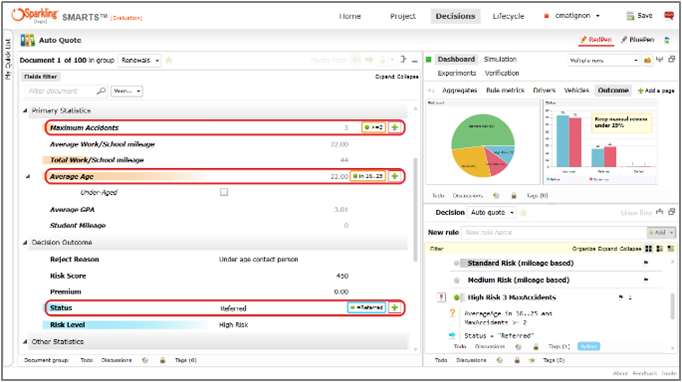Sparkling Logic are being SMARTS with Decisions
Sparkling Logic is a specialist software and consulting company in decision management. The company was founded in 2010 and has its headquarters in Sunnyvale, California. I was briefed at the end of January by Davorin Kuchan, their CEO and two of their founders, Carlos Serrano-Morales and Carole Ann Berlioz; both of whom are ex-Fair Isaac executives. The company has developed SMARTS, which combines Prescriptive Analytics and Enterprise Decision Management capabilities. Its objective is to capture and improve the decision logic for business decisions by helping experts share what they know and their interpretations of policies and regulations. Business analysts can define business rules and derive logic from data. This is combined with the ability to look for the rules in the actual underlying data of an organisation, thus allowing the decision logic that impacts a metric or objective.

Figure 1: Sparkling Logic’s SMARTS environment (Source: Sparkling Logic)
The business analyst workstation, PENCIL Decision Modeler, is sold separately as well as being part of SMARTS. It uses the Decision Model and Notation (DMN) standard of the Object Management Group (OMG) to model the decisions. DMN enables the user to document decision processes in a structured and formalised manner and enables linking to BPMN diagrams. PENCIL captures the business rules that define a decision or sub-decision in decision tables or text-based rules. These rules may be totally free-form, or use syntax. There is a glossary which allows a user to define their organisation’s terms, thus clarifying business meaning and standard use of terminology. Decision inputs and outputs can be added to the glossary. The terms in the glossary can be grouped into categories. The Rule Assist editor in PENCIL automatically completes and provides hints to the user when defining business rules. Once a decision model is complete it can be loaded to a SMARTS project, which then allows the model to be executed and tested using the simulation capabilities of SMARTS.
The Purpose of the DMN standard is to provide business decision (rules) which can be depicted in a diagrammatic notation. It allows both decision requirements and decision logic to be separated from the actual business process. The DMN standard is complementary to the BPMN standard. BPMN defines a special kind of activity, the Business Rule Task, which provides a mechanism for the process to provide input to a business rule engine and to get the output of calculations that the business rule engine might provide. |
One of the real differentiators in SMARTS is the patented ‘design by doing’ approach called RedPen that allows business users to capture decision logic in the context of use cases and highlight using a red box around the identified fields that are referenced by the rule.

Figure 2: An example of RedPen in use (Source: Sparkling Logic)
The simulation capability allows the user to define KPI’s and metrics to track decision performance for decisions, documents and/or rules. Alternative decision strategies can then be compared against different data samples; these can be large datasets.
The big differentiator of SMARTS is its support of both decision management capabilities and prescriptive analysis techniques. SMARTS’s predictive analysis capabilities include Predictive Model Markup Language (PMML) import and Rules Induction. The latter uses another Sparkling Logic patent-pending capability called BluePen, which allows users to introduce rules from the underlying data by identifying predictors.
The Predictive Model Markup Language (PMML) is an XML-based predictive model interchange format that provides a way for analytic applications to describe and exchange predictive models produced by data mining and machine learning algorithms. It supports common models such as logistic regression and feed forward neural networks. |
One of the key USPs that Sparkling Logic presents about SMARTS is what they term 4-D (Data, Dashboard, Discussions, Decision Logic). There are 4 key propositions in the products:
- Data: Everything is done in context of using views of real data, familiar forms, and real metrics.
- Dashboards: The impact of rules and rule changes on the data, outcomes and metrics is always shown immediately in the SMARTS Dashboard. RedPen and BluePen modules are good examples of this visibility.
- Discussions: SMARTS is built on a collaborative platform that allows groups and teams to work together and share information. Ad-hoc discussions and task assignments can be captured and managed in the context of decision logic.
- Decision Logic: The logic can be defined in a number of different ways which can be used together. Once captured SMARTS provides good simulation capabilities to test the accuracy and relevance in different situations
Sparkling Logic offer SMARTS both on-premise or in the Cloud. Its current customer base is in the financial services, insurance, distribution, government, energy and healthcare sectors. In these sectors, SMARTS has been used for Fraud Detection and Rapid Response, Compliance, Customer Acquisition and Management, Underwriting, Eligibility and Enrolments and Claims Processing. One of their customers, ABT Power Management, used SMARTS to combine data analytics from devices and remote sensors to drive compliance, repair, and maintenance decisions. The company has customers in Internet of Things and Industrial sectors.
Sparkling Logic’s SMARTS is definitely a solution in Bloor’s view that should be considered if an organisation is looking at decision management automation across any sector, whilst still providing all the necessary support for business rules management.
